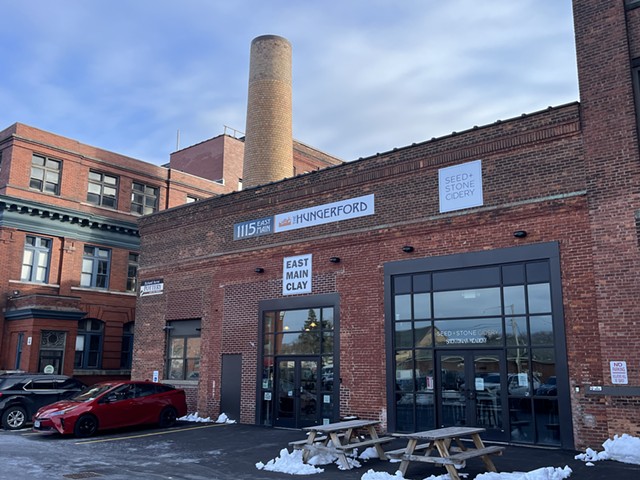
- PHOTO BY DAVID ANDREATTA
- The Hungerford Building on East Main Street has been a refuge for working artists since the 1990s.
For the better part of 30 years, working artists have been drawn to the Hungerford Building on East Main Street by the promise of inexpensive rent and a supportive creative community.
But on Tuesday, a couple dozen of them were drawn to a painter’s studio on the fourth floor of the complex to form a tenants’ union, with the goal of pressing their landlord to end practices that they claim have led to an exodus of artists from the building.
The 26 printers, potters, and other creative types who voted shared stories of how their stability has been shaken since the building was sold a year ago to real estate developer Peter Hungerford, a distant relation of the late food-processing magnate J. Hungerford Smith, who built the sprawling former soda syrup factory in the early 1900s.
“I really hate what’s going on and I guess I’m scared,” said Jason Ferguson, a ceramics artist who works and lives in the building and led the tenant meeting.
“This is like my sanctuary, this is where I come to express what’s in my soul, and that’s in jeopardy right now,” Ferguson went on. “There’s like a whole bunch of uncertainty.”
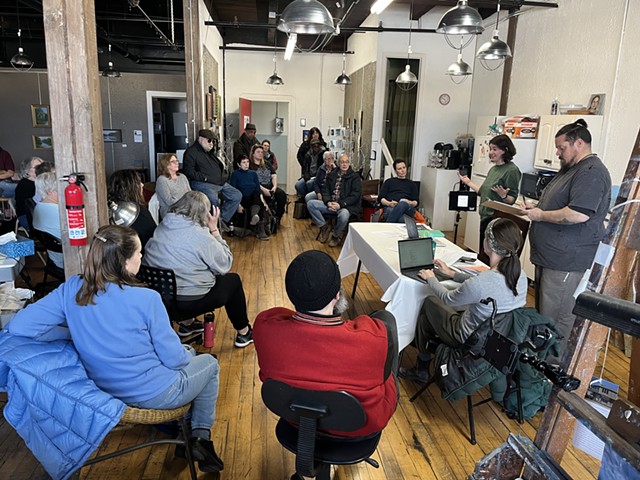
- PHOTO BY DAVID ANDREATTA
- About two dozen artists who work out of the Hungerford Building gathered to vote to form a tenants' union on March 7, 2023.
The latter is what Julia Deal said led her to recently move her business, SEW Artistic, to East Rochester when her lease expired after eight years in the Hungerford.
“I just can’t make plans and organize my business properly never knowing whether I’m going to be able to stay in my space or not,” Deal said.
Advocates for tenants unions say strong ones can force landlords — or the banks who finance them or the politicians who approve their projects — to listen. As a group, tenants can have more leverage to take action, like going to court or organizing rent strikes.
Reached by phone, Hungerford acknowledged that his practices have caused angst among tenants, but dismissed the notion that artists were leaving in droves.
He estimated that he has lost 20 tenants — out of about 170 — and said that he has accommodated a handful of others whose long-term leases expired with upgraded spaces specifically tailored to their needs.
“We have never kicked a single person out or asked them to leave,” he said. “We do expect to offer longer-term leases, maybe as early as later this year.”
Hungerford insisted the measures he has taken were necessary for him to get to know the property and maintain it more effectively in the long-term as a home for working artists.
The building is an amalgam of interlocking structures that together span some 225,000 square feet.
Hungerford said that since he acquired the place he has invested more than $1 million in repairing elevators, the parking lot, and security systems — work that he described as being in the process of being completed.
“This building is like an onion, and I’m taking it layer by layer,” he said. “To me, it just simply makes much more sense in the long run to take this piece by piece.”
Tenants were notified by letter shortly after the sale of the building last spring that their long-term leases would not be renewed — a twist that they viewed then with suspicion.
As the months passed and leases expired, however, the consequences of the practice have come to roost in the form of rising vacancies, which tenants said have left them feeling like their community is collapsing.
“It’s been very sad to see something that we’ve built up as a group, the whole building, to be shredded and torn down,” said Loree Harpole, a portrait artist at the Hungerford.
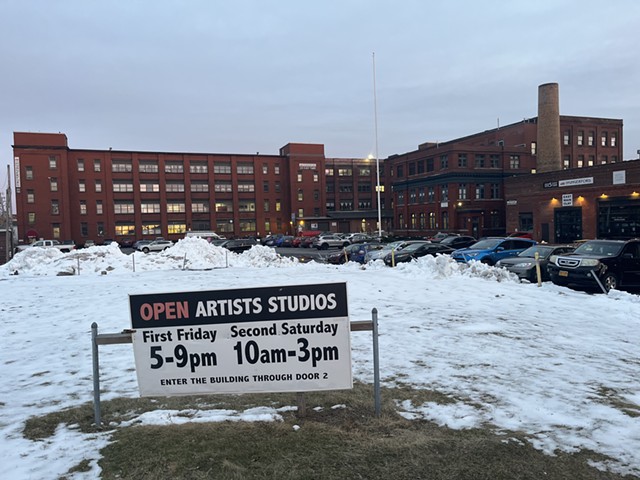
- PHOTO BY DAVID ANDREATTA
- The Hungerford Building is the hub of city-wide artist showcases known as First Fridays and Second Saturdays.
He said he pays $5.50 per square foot in rent and that every other location he has inquired about charges twice as much.
“I don’t know where I’m going to move my business if I have to move from here,” Zanni said. “This is one of the most affordable spaces in the city.”
In the last few months, escalating common area maintenance fees have led some tenants to wonder whether they are being gouged to make up for lost rental revenue.
Hungerford acknowledged that those fees have climbed, but said they were being shared fairly. He cited a letter he sent to tenants last year that notified them of upcoming changes to common area charges and asserted that the way they had been previously handled was "misaligned with industry standard practice."
Further fueling tenants’ suspicions about Hungerford — and their drive to organize — is Hungerford’s track record in Rochester.
He was among several investors who owned a pair of apartment buildings whose tenants stopped paying rent in 2018 to protest substandard living conditions. The city eventually sued over code violations and the investors sold the properties the following year.
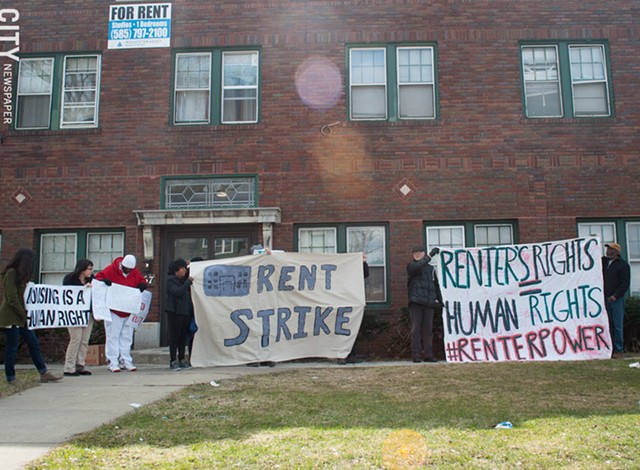
- PHOTO BY JAKE CLAPP
- Tenants at 967 Chili Ave. rally outside of their building in 2018 to protest poor conditions. Peter Hungerford and other investors owned the building.
RELATED: City plans suit against landlord Peter Hungerford
He cast his interactions with occupants of the Hungerford Building as transparent and called any suggestion otherwise “insulting.”
Monroe County Legislator Rachel Barnhart earlier this year brokered a meeting between Hungerford and a few concerned tenants.
“He looked them straight in the eye and said, ‘I’m not going to kick you out,’” she said. “But he also made it very clear that he’s trying to strike a balance between making space affordable and financing improvements.”
She said the county has microloan programs that may help some artists.
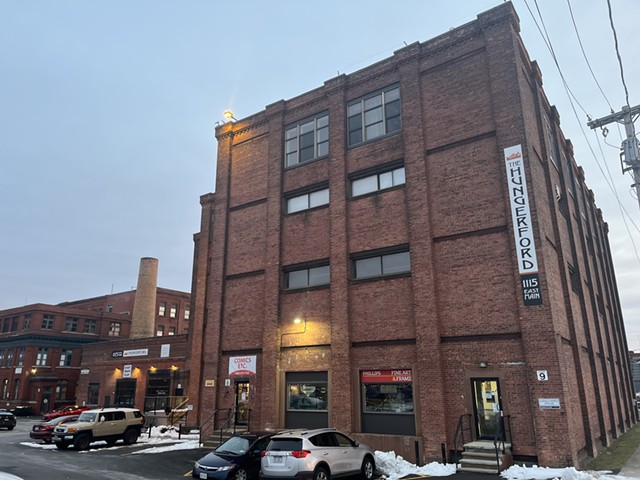
- PHOTO BY DAVID ANDREATTA
- The Hungerford Building on East Main Street has been a refuge for working artists since the 1990s.
Hungerford insisted he is. He said that in addition to upgrading less visible infrastructure in the guts of the building, he has plans to invest $500,000 in building out 12,000 square feet in the basement that has gone unused for decades.
Meanwhile, the departures of artists have stoked speculation among those who remain that Hungerford intends to slowly root out all of them to make way for tenants who are willing to pay more or convert the building into high-end condominiums.
Hungerford denied having ulterior motives.
“If I wanted to do that, I would have done that already,” he said. “I haven’t for a reason — because I expect to maintain this as an artists’ community.”
Editor's Note 3.10.23: This article has been updated from its original version to reflect additional source material provided after publication by Peter Hungerford regarding common area charges and his previous real estate holdings in Rochester.
David Andreatta is CITY's editor. He can be reached at [email protected].
